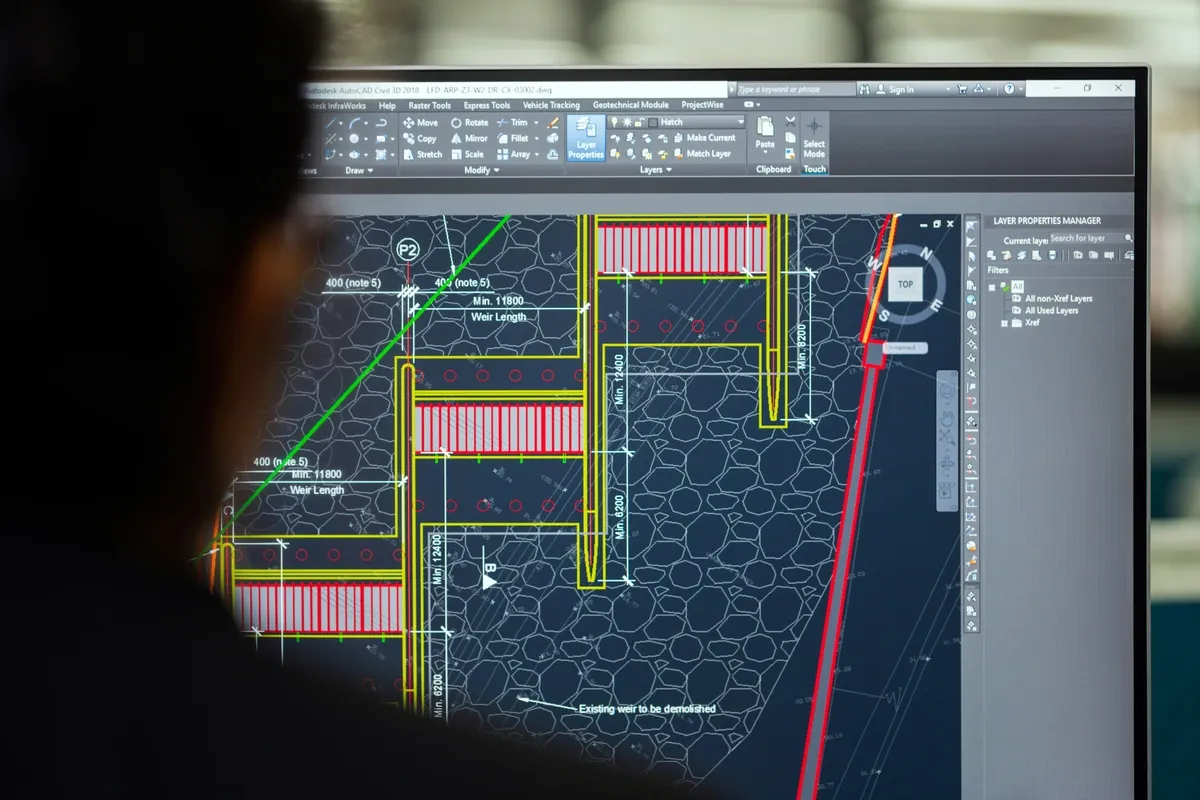
Advanced simulation software has revolutionized the engineering design and testing landscape by enhancing design accuracy, reducing prototyping costs, and accelerating project timelines. These powerful tools, such as Finite Element Analysis (FEA) and Computational Fluid Dynamics (CFD), enable engineering firms to conduct detailed and precise simulations, leading to better-informed decision-making and improved project outcomes. By integrating such cutting-edge technology into their workflows, engineering firms can maintain high standards of quality control and efficiency, ensuring they remain competitive in a rapidly evolving industry.
The Importance of Advanced Simulation Software in Engineering
Simulation software in the engineering industry refers to tools that allow engineers to model real-world phenomena using computational algorithms. These tools enable the analysis of various physical systems, including fluid dynamics, structural mechanics, and electromagnetic fields. The main goal is to predict how products will perform under different conditions, thereby avoiding the need for costly physical prototypes ( source ).
Benefits of Using Advanced Simulation Software
Enhancing Design Accuracy : Advanced simulation software allows engineers to create highly detailed models that closely mimic real-world conditions. This results in more accurate predictions of how a design will perform, reducing the likelihood of errors and improving overall quality. For instance, simulations can predict stress points in a structure, helping to optimize material use and design ( source ).
Reducing Prototyping Costs : Traditional engineering workflows often require multiple physical prototypes, each iteration involving considerable time and expense. Simulation software significantly reduces the need for these prototypes by allowing virtual testing and validation. This cost-saving benefit is particularly valuable in industries where materials and testing are expensive ( source ).
Accelerating Project Timelines : By enabling rapid testing and iteration cycles, simulation software can dramatically speed up the design process. Engineers can quickly tweak designs and immediately see the impact of these changes, thereby accelerating the development timeline. This is especially beneficial for projects with tight deadlines, allowing for faster market entry ( source ).
Real-World Examples of Successful Implementation in Engineering Firms
Automotive Industry : In the automotive sector, companies like Tesla use advanced simulation software to design and test vehicle components. Simulations of crash tests, aerodynamics, and thermal management systems are conducted to ensure safety and performance before any physical prototypes are built. This approach has led to significant cost savings and faster development cycles ( source ).
Aerospace Industry : NASA and other aerospace organizations utilize simulation software for a variety of applications, from designing spacecraft to analyzing the behavior of materials in extreme conditions. For example, simulations help in understanding the thermal dynamics of reentry vehicles, ensuring that they can withstand the intense heat and stress during reentry ( source ).
Civil Engineering : In civil engineering, advanced simulation tools are used to model the behavior of structures under different load conditions. For instance, engineers use FEA to simulate the stresses and strains on a bridge, ensuring that it can withstand environmental impacts like wind, earthquakes, and heavy traffic loads. This helps in creating safer and more resilient infrastructure ( source ).
By leveraging these benefits, engineering firms can enhance their design accuracy, reduce costs, and accelerate project timelines, ensuring they remain competitive and efficient in a rapidly evolving industry.
Key Features and Capabilities of Advanced Simulation Software
Advanced simulation software offers a range of powerful features that are crucial for enhancing engineering design and testing processes. Among these features, Finite Element Analysis (FEA), Computational Fluid Dynamics (CFD), and Multiphysics simulations stand out due to their significant impact on project outcomes.
Finite Element Analysis (FEA)
FEA is a numerical method that predicts how products will respond to real-world forces, vibration, heat, and other physical effects. This method is invaluable during the design and testing phases of engineering projects.
- Detailed Analysis : FEA enables engineers to analyze complex structures and assemblies, providing insights into stress distribution, deformation, and potential failure points ( source ).
- Soil-Structure Interaction : Essential for designing foundations, retaining walls, and tunnels, ensuring stability and safety ( source ).
- Dynamic Analysis : Utilized for structures subjected to seismic loads, helping to ensure they can withstand earthquakes.
- Pavement and Waste Management Design : Aids in creating durable pavements and stable waste containment systems.
Computational Fluid Dynamics (CFD)
CFD is used to analyze fluid flow within and around objects, which is critical in fields like automotive, aerospace, and chemical engineering.
- Flow Analysis : Simulates fluid flow to optimize designs for efficiency and performance ( source ).
- Heat Transfer : Analyzes thermal effects and heat dissipation in products, ensuring effective thermal management.
- Aerodynamics : Critical for designing vehicles and aircraft, CFD helps reduce drag and improve fuel efficiency.
Multiphysics Simulations
Multiphysics simulations integrate multiple physical phenomena into a single model, enabling a comprehensive analysis of complex interactions.
- Integrated Analysis : Simultaneously analyzes mechanical, thermal, fluid, and electromagnetic effects, providing a holistic view of the design ( source ).
- Complex Interactions : Models the interactions between different physical phenomena, leading to more accurate predictions of real-world behavior.
How These Features Contribute to Improved Design and Testing Phases
Enhanced Accuracy and Precision
Advanced simulation software provides high-fidelity models that mirror real-world conditions, enabling precise predictions and reducing the risk of design failures.
Cost Efficiency
Simulating various scenarios allows engineers to identify and resolve potential issues before building physical prototypes, significantly cutting down on material costs and development time.
Accelerated Time-to-Market
Streamlined simulation processes enable faster iterations and optimizations, allowing products to reach the market quicker.
Case Studies Showing the Impact of Specific Features on Project Outcomes
- Automotive Industry : A car manufacturer used CFD to optimize the aerodynamics of a new vehicle model, resulting in a 10% improvement in fuel efficiency.
- Aerospace : An aerospace company utilized FEA to enhance the structural integrity of an aircraft wing, leading to a lighter and stronger design.
- Civil Engineering : A construction firm applied FEA for slope stability analysis, ensuring the safety and reliability of a new infrastructure project.
By leveraging these advanced features, engineering firms can significantly improve their design accuracy, reduce costs, and accelerate project timelines. This ensures high-quality, reliable solutions that meet the demands of a competitive and rapidly evolving industry. For more information on how Minute7 can assist with time tracking and expense reporting for your projects, sign up for a free trial or visit Minute7 .
Implementing Advanced Simulation Software: Best Practices and Considerations
Implementing advanced simulation software in engineering firms can be a transformative step towards increased efficiency and accuracy. However, to gain the maximum benefits, it’s essential to follow best practices and be aware of common challenges.
Steps for Integrating Simulation Software into Existing Workflows
Initial Assessment and Selection of Appropriate Software
-
Define the Problem and Objectives : Start by clearly defining the problem you aim to solve with the simulation and set specific objectives. This includes understanding the scope, constraints, and performance measures. Using structured approaches like SMART (Specific, Measurable, Achievable, Relevant, Time-bound) can help in this phase ( source ).
-
Evaluate Software Options : Conduct a thorough assessment of available software by considering factors such as ease of use, integration capabilities, scalability, and cost. Ensure that the software aligns with your specific engineering needs and can seamlessly integrate with existing systems ( source ).
-
Pilot Testing : Before full-scale implementation, conduct pilot tests to evaluate the software’s performance in real-world scenarios. This helps identify potential issues and refine the integration process.
Training and Support for Engineering Teams
-
Comprehensive Training Programs : Invest in comprehensive training programs that include hands-on sessions, workshops, and online resources. These should cover both basic and advanced features to ensure all users can utilize the software effectively ( source ).
-
Ongoing Support and Resources : Establish a support system that includes access to technical support, user guides, and a knowledge base. Encourage continuous learning and provide opportunities for advanced training and webinars.
Common Challenges and How to Overcome Them
-
Data Collection and Analysis : Gathering sufficient and reliable data is often a challenge. Overcome this by using appropriate data sources, applying statistical techniques, and ensuring data quality through validation processes ( source ).
-
Software Usability : The complexity of simulation software can hinder its usability. Implement user-friendly interfaces and guided workflows to simplify the process and reduce the learning curve ( source ).
-
Integration with Existing Systems : Ensuring seamless integration with existing systems can be challenging. Address this by selecting software with robust integration capabilities and collaborating closely with IT teams to manage the integration process.
Tips for Maximizing the Benefits of Simulation Software
Regular Updates and Maintenance
-
Keep Software Updated : Regularly update the simulation software to access the latest features, improvements, and security patches. This ensures optimal performance and the ability to tackle new challenges effectively.
-
Routine Maintenance : Perform routine maintenance checks to ensure the software and hardware are functioning correctly. Address any issues promptly to avoid disruptions.
Leveraging Cloud-Based Solutions
-
Utilize Cloud-Based Platforms : Cloud-based simulation software offers scalability, flexibility, and reduced infrastructure costs. It allows teams to access simulation tools from anywhere, facilitating remote work and collaboration ( source ).
-
Enhance Collaboration : Cloud-based solutions enable real-time collaboration among team members, improving communication and speeding up the decision-making process. It also allows for easier sharing of simulation results and insights.
By following these best practices and addressing common challenges, engineering firms can effectively implement advanced simulation software to enhance their project outcomes. Minute7, with its seamless integration capabilities and user-friendly platform, is ideally positioned to support engineering firms in their quest for efficiency and innovation. To experience the advantages firsthand, sign up for a free trial at Minute7 or learn more about our offerings .
Leveraging Advanced Simulation Software to Transform Engineering Projects
Incorporating advanced simulation software into engineering design and testing processes can profoundly impact project outcomes, driving innovation and efficiency. These powerful tools, such as Finite Element Analysis (FEA), Computational Fluid Dynamics (CFD), and Multiphysics simulations, allow engineering firms to achieve enhanced design accuracy, reduced prototyping costs, and accelerated project timelines. By following best practices for implementation and overcoming common challenges, engineering teams can unlock the full potential of these technologies.
Engineering firms that effectively integrate advanced simulation software into their workflows can expect precise predictions, minimized risks, and streamlined development cycles. For example, firms can conduct virtual tests and iterations, which significantly cut down on material costs and time, ensuring that projects are delivered on time and within budget. Moreover, the ability to simulate complex real-world interactions and conditions leads to better-informed decisions and higher quality designs.
To maximize the benefits of simulation software, it is crucial to invest in comprehensive training programs, ensure regular software updates, and leverage cloud-based solutions for improved collaboration and scalability. By staying updated with the latest features and maintaining robust support systems, engineering teams can continuously improve their skills and adapt to evolving project demands.
Minute7 understands the importance of efficiency and accuracy in engineering projects. Our platform provides seamless time tracking and expense reporting solutions that integrate directly with QuickBooks, enabling engineering firms to focus on what they do best—innovate and deliver high-quality projects. By choosing Minute7, you can streamline administrative tasks, ensuring that your team has more time to dedicate to critical design and testing activities.
Experience the advantages of Minute7 firsthand by signing up for a free trial or learning more about our offerings . Let Minute7 support your engineering firm’s journey towards greater efficiency and innovation.



